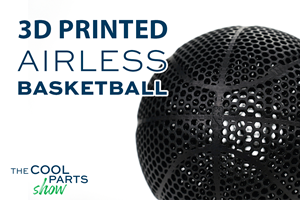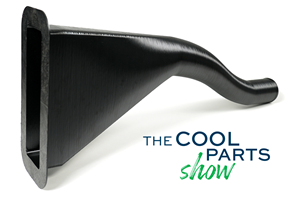Carbon and Hypsole Creating 3D Printed Athletic Guards for Cleats
Designed for athletes across all levels of competition, the guards work like removable outsoles, transforming cleats into functional, sneaker-like footwear that athletes can wear anywhere, and are compatible with a wide range of cleat models and sports.
The adjustable button-and-strap design enables athletes to customize the fit of their guards to accommodate varying cleat heights and widths. Source: Carbon/Hypsole
Specialty sports footwear company Hypsole is launching what it says the first-ever, 3D printed cleat guards using Carbon’s Digital Light Synthesis (DLS) technology. Designed for athletes across all levels of competition, the brand’s first model release, Tidal 3D Elite, is said to offer functionality, convenience, protection and comfort with a sleek look and feel.
The guards work like removable outsoles, transforming cleats into functional footwear that athletes can walk in anywhere. Tidal 3D Elite is compatible with a wide range of cleat models available from major brands for football, soccer, lacrosse, baseball, softball, rugby and ultimate frisbee. The brand was founded by former Division I track and field athlete, Jes Christian, whose college and professional experiences in fashion and sports, eventually led her back to the cleat guard concept.
“Once the functional requirements of the product were established, the aesthetic — from fit to finish —became a top priority. I didn’t want this product to be just another piece of sports equipment. I wanted fashion and streetwear to be infused into the design visuals,” says Jes Christian, Hypsole founder and CEO. “I felt strongly that it needed to look good and that we needed athletes to want it as much as, if not more than, they needed it. Because, at the end of the day, if it works but it’s not hitting aesthetically, then we’re going to be fighting an uphill battle with our target demo.”
Tidal 3D Elite was developed to resemble a sneaker when coupled with an athlete’s cleat through features that help bring the balance of function and fashion to life. The guards were designed to follow the natural curve of common cleat silhouettes, while maintaining a firm grip to keep cleats in place while an athlete is in motion. The adjustable button-and-strap design enables athletes to customize the fit of their guards to accommodate varying cleat heights and widths, while the heel notch gives them a quick and easy way to remove their guards while seated or standing.
The Tidal 3D Elite features a lightweight lattice 3D design with strategic support regions and tough tread for optimal durability. In collaboration with Carbon, Hypsole is manufacturing its first product using DLS — a 3D printing process that uses digital light projection to cure liquid resin, producing products with functional and visual properties that cannot be produced with traditional manufacturing processes.
Over the course of a year, the product’s original design was modified for Carbon DLS. And with input from Carbon’s team, the brand made the decision to leverage Carbon’s Elastomeric Polyurethane (EPU) — a 40% biobased material that rivals the performance of the standard thermoplastic polyurethanes often used in the production of sneaker outsoles — for the entire construction of the athletic cleat guards.
“Carbon’s technology was developed to bring about products that push the boundaries of what’s possible no matter the markets or industry — and Hypsole is no exception,” says Phil DeSimone, Carbon co-founder and office of the CEO. “We’re proud to partner to bring its revolutionary sports footwear concept to life with Carbon’s DLS technology, enabling improved performance for athletes at all levels.”
Tidal 3D Elite comes in two colors (Calcite Hex and Onyx Hex) and 10 unisex sizes. All Hypsole cleat guards run on a custom unisex sizing system, covering a U.S. child’s size 1 up through U.S. men’s and women’s adult sizes.
Related Content
Airless Basketball Shows Promise of 3D Printed Lattices: The Cool Parts Show Bonus
Successfully matching the performance of a standard basketball demonstrates the control possible over the mechanical properties of digital materials.
Read MoreConcept Sneaker Boasts One-Piece 3D Printed TPU Construction
The Reebok x Botter Concept Sneaker Engineered by HP premiered at Paris Fashion Week, hinting at manufacturing possibilities for the future of footwear.
Read More6 Trends in Additive Manufacturing Technology at IMTS 2024
3D printers are getting bigger, faster and smarter. But don’t overlook the other equipment that the AM workflow requires, nor the value of finding the right supplier.
Read MoreAircraft Ducts 3D Printed in Composite Instead of Metal: The Cool Parts Show #68
Eaton’s new reinforced PEKK, tailored to aircraft applications, provides a cheaper and faster way to make ducts compared to formed aluminum.
Read MoreRead Next
Bike Manufacturer Uses Additive Manufacturing to Create Lighter, More Complex, Customized Parts
Titanium bike frame manufacturer Hanglun Technology mixes precision casting with 3D printing to create bikes that offer increased speed and reduced turbulence during long-distance rides, offering a smoother, faster and more efficient cycling experience.
Read MorePostprocessing Steps and Costs for Metal 3D Printing
When your metal part is done 3D printing, you just pull it out of the machine and start using it, right? Not exactly.
Read MoreProfilometry-Based Indentation Plastometry (PIP) as an Alternative to Standard Tensile Testing
UK-based Plastometrex offers a benchtop testing device utilizing PIP to quickly and easily analyze the yield strength, tensile strength and uniform elongation of samples and even printed parts. The solution is particularly useful for additive manufacturing.
Read More





















